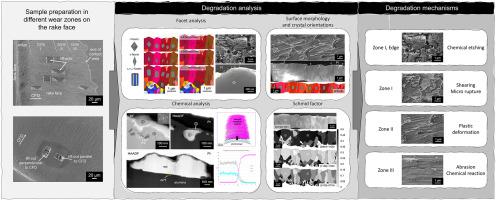当前位置:
X-MOL 学术
›
Int. J. Mach. Tool Manu.
›
论文详情
Our official English website, www.x-mol.net, welcomes your feedback! (Note: you will need to create a separate account there.)
Enhanced steel machining performance using texture-controlled CVD alpha-alumina coatings: Fundamental degradation mechanisms
International Journal of Machine Tools and Manufacture ( IF 14.0 ) Pub Date : 2024-02-28 , DOI: 10.1016/j.ijmachtools.2024.104137 S. Shoja , O. Bäcke , A. Fazi , S. Norgren , H.-O. Andrén , M. Halvarsson
International Journal of Machine Tools and Manufacture ( IF 14.0 ) Pub Date : 2024-02-28 , DOI: 10.1016/j.ijmachtools.2024.104137 S. Shoja , O. Bäcke , A. Fazi , S. Norgren , H.-O. Andrén , M. Halvarsson

|
Cemented carbide inserts coated with CVD α-alumina, particularly those exhibiting a (0001) texture, have proven highly effective in steel turning. Despite the established superior performance of (0001) textured alumina coatings, the underlying reasons remain unclear. This study explores the influence of the crystallographic texture of alumina on wear mechanisms in various chip-tool contact zones on the insert rake face. The objective is to establish a fundamental understanding of the active degradation mechanisms and machining performance by relating coating texture to the orientation and deformation of individual AlO grains. Two multilayered coatings, AlO on Ti(C,N), featuring (0001)- and -textured CVD α-alumina, were assessed in dry turning of a bearing steel. The wear rate of the coating was double that of the (0001) coating. Worn coatings exhibit nano-terrace formation at the insert edge, likely due to chemical etching. In the sticking zone, plastic deformation leads to larger facets for grains oriented with the chip flow direction, while rounded surfaces result if this condition is not met. In the transition zone, both (0001) and textured coatings undergo increased plastic deformation accompanied by sub-surface dislocations. (0001) texture deforms more by basal slip creating a wavy coating pattern with steps present at larger misalignments of the lattice planes in neighboring grains while texture deforms by several slip systems creating elongated ridges and ruptured-like areas resulting in rougher surface. This difference in surface morphology is then inherited by the abrasion of submicron coating fragments embedded in the chip (more in texture) in the sliding zone resulting in an even rougher surface. Chemical reaction with the hot chip may also contribute to wear acting as an additional mechanism. This fundamental understanding contributes to the potential enhancement of steel machining using texture-controlled CVD alumina coatings, ultimately improving coated cutting tool performance.
中文翻译:

使用织构控制的 CVD α-氧化铝涂层增强钢材加工性能:基本降解机制
事实证明,涂有 CVD α-氧化铝的硬质合金刀片,特别是具有 (0001) 织构的硬质合金刀片,在钢车削中非常有效。尽管 (0001) 织构氧化铝涂层具有优异的性能,但其根本原因仍不清楚。本研究探讨了氧化铝晶体织构对刀片前刀面上各种切屑工具接触区域磨损机制的影响。目的是通过将涂层纹理与单个 Al2O3 晶粒的取向和变形联系起来,建立对主动降解机制和加工性能的基本了解。在轴承钢的干车削中评估了两种多层涂层,即 Ti(C,N) 上的 Al2O,具有 (0001) 和织构的 CVD α-氧化铝。涂层的磨损率是(0001)涂层的两倍。磨损的涂层在刀片边缘处表现出纳米阶地的形成,这可能是由于化学蚀刻造成的。在粘着区,塑性变形会导致沿切屑流动方向取向的晶粒产生更大的刻面,而如果不满足此条件,则会产生圆形表面。在过渡区,(0001) 和纹理涂层都会经历增加的塑性变形,并伴有亚表面位错。 (0001) 纹理通过基底滑移产生更多的变形,形成波状涂层图案,相邻晶粒中晶格平面的较大错位处存在台阶,而纹理通过几个滑移系统变形,产生细长的脊和破裂状区域,从而导致更粗糙的表面。这种表面形态的差异会通过嵌入在滑动区域的芯片(更多的是纹理)中的亚微米涂层碎片的磨损而继承,从而导致更粗糙的表面。作为一种附加机制,与热切屑的化学反应也可能导致磨损。这一基本认识有助于使用织构控制的 CVD 氧化铝涂层潜在地增强钢加工性能,最终提高涂层切削刀具的性能。
更新日期:2024-02-28
中文翻译:

使用织构控制的 CVD α-氧化铝涂层增强钢材加工性能:基本降解机制
事实证明,涂有 CVD α-氧化铝的硬质合金刀片,特别是具有 (0001) 织构的硬质合金刀片,在钢车削中非常有效。尽管 (0001) 织构氧化铝涂层具有优异的性能,但其根本原因仍不清楚。本研究探讨了氧化铝晶体织构对刀片前刀面上各种切屑工具接触区域磨损机制的影响。目的是通过将涂层纹理与单个 Al2O3 晶粒的取向和变形联系起来,建立对主动降解机制和加工性能的基本了解。在轴承钢的干车削中评估了两种多层涂层,即 Ti(C,N) 上的 Al2O,具有 (0001) 和织构的 CVD α-氧化铝。涂层的磨损率是(0001)涂层的两倍。磨损的涂层在刀片边缘处表现出纳米阶地的形成,这可能是由于化学蚀刻造成的。在粘着区,塑性变形会导致沿切屑流动方向取向的晶粒产生更大的刻面,而如果不满足此条件,则会产生圆形表面。在过渡区,(0001) 和纹理涂层都会经历增加的塑性变形,并伴有亚表面位错。 (0001) 纹理通过基底滑移产生更多的变形,形成波状涂层图案,相邻晶粒中晶格平面的较大错位处存在台阶,而纹理通过几个滑移系统变形,产生细长的脊和破裂状区域,从而导致更粗糙的表面。这种表面形态的差异会通过嵌入在滑动区域的芯片(更多的是纹理)中的亚微米涂层碎片的磨损而继承,从而导致更粗糙的表面。作为一种附加机制,与热切屑的化学反应也可能导致磨损。这一基本认识有助于使用织构控制的 CVD 氧化铝涂层潜在地增强钢加工性能,最终提高涂层切削刀具的性能。












































 京公网安备 11010802027423号
京公网安备 11010802027423号